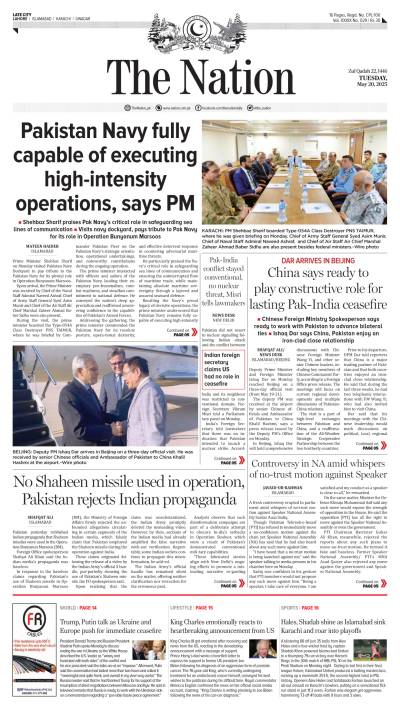KARACHI - Saran Thaimor, the elderly fisherwoman was guiding young girls at an open courtyard in remote Ahmed Thaimor village near Jati town, Thatta district to complete embroidery work to prepare bride’s dresses. The bride is her niece belonging to the same locality. “We being close relatives work together on such happy occasions to prepare dresses for grooms and brides and design other handmade items for home decoration to make the events more colourful,” she told this scribe while narrating her story. Being traditionally well skilled in their work, all the village women usually perform this work in day time. But since they have got street solar lights, installed recently at the centers of combined courtyards, they take it blessing to continue working till late night. Saran claims to have more skills, including sewing clothes, doing embroidery with variety of designs and making traditional ralli quilts. Now she spares time to shift these skills to younger girls in the locality. “We usually do this work at daytime. But since we have solar lights now we prefer to make the time useful by continue working till late night,” she said. She accredits Behar-Al Sindh Foundation (BASF) for installing the solar lanterns in collaboration with USAID Small Grants and Ambassador Fund Programme (SGAFP). This small scheme has benefitted residents of some 15 coastal villages in Union Council Karmalik, all of which previously had no access to electricity.Nasiban Thaimor, the young niece of Saran was also doing embroidery work with other girls working in the same group. BASF Executive Director Zaffar Soomro, sharing his contribution, said, “We identified this community because they did not have access to electricity. They are living 15—20-km away from the government’s electricity providers. Looking to the political scenario we can guess there is no hope, which may bring little change in their life for the next several years.” Village elder Jumo Thaimor said, “We have approached local political leaders but as always received promises, which never come true. We cannot imagine having access to light soon.” “We are happy to see our children reading books, doing home works till late night and playing with each other,” he said. The community has formed some 50 groups operating in the localities, where these solar street lights have been installed. Each group collects Rs50 from each household for the monthly maintenance of these installations. However, the elderly woman Saran said actual beneficiaries are skilled women, who continue their working till late night on the light of solar lanterns. The village comprising 48 houses is located at the mouth of disasters, cyclones and floods. The families depend on the sea for fishing, which is only source of livelihood for the majority of coastal communities.The mother of 10 children — five sons and five daughters — Saran is eye witness of ups and downs in the sea. When cyclone hits the area in May 1999, it destroyed all the makeshift abodes, killing a large number of people and animals with destruction all around. Recalling the haunting experience, she said, “At that time we all were at homes (makeshift huts) and saw strong winds with high tides together started suddenly, pushing us to face the devastating disaster. We could not cook meal for three days consecutively, kept continue praying for help,” she narrates the episode. “When it settled down, we saw destruction everywhere. We lost shelters. Then our males remained busy in collecting bodies of family relatives in each village for their funeral,” she said. “We will never forget that devastating disaster. Now whenever we receive warning call about any natural calamity we leave our abodes to safer places without any delay,” she said. The stream ends near there, hence local people call it as controversial Sir Creek, which divides sea borders between Pakistan and India.
Tuesday, May 20, 2025
Solar lights lighten village women’s lives

EU approves its 17th sanctions package against Russia
3:36 PM | May 20, 2025
Govt declares public holiday on May 28 to mark Youm-e-Takbeer
2:40 PM | May 20, 2025
Pakistan plans to secure $4.9bn in commercial loans for FY2025-26
2:33 PM | May 20, 2025
US cancels another $60M in grants to Harvard University
1:14 PM | May 20, 2025
Excavation resumes at Mohenjo Daro after 18 years, UNESCO leads effort
1:12 PM | May 20, 2025
-
Lahore emerges among safest global cities in Numbeo 2025 index
-
Lahore emerges among safest global cities in Numbeo 2025 index
-
India’s suspension of Indus Water Treaty legally baseless
-
Seventh polio case reported in Pakistan amid nationwide vaccination drive
-
Pakistan reports sixth polio case of 2025
-
PTA begins issuing VPN licences to regulate usage
The Wider War
May 20, 2025
Margalla on Fire
May 20, 2025
Defeated and Depressed
May 20, 2025
Regional Reset
May 19, 2025
Peak Potential
May 19, 2025
Worse than Anarchy
May 20, 2025
Salute to our Air Force
May 20, 2025
An Unbreakable Wall
May 20, 2025
Profiteering Milk
May 20, 2025
Rewriting the Rules
May 20, 2025
ePaper - Nawaiwaqt
Nawaiwaqt Group | Copyright © 2025





